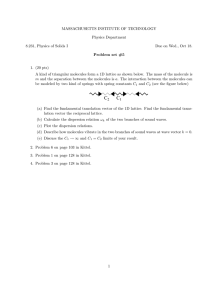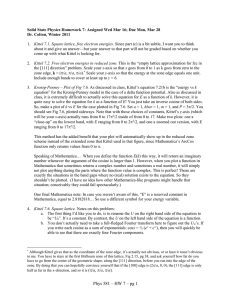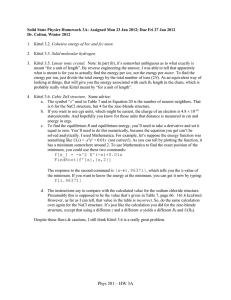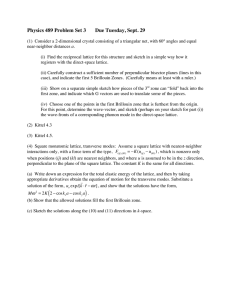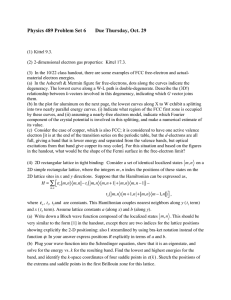hw 7
advertisement
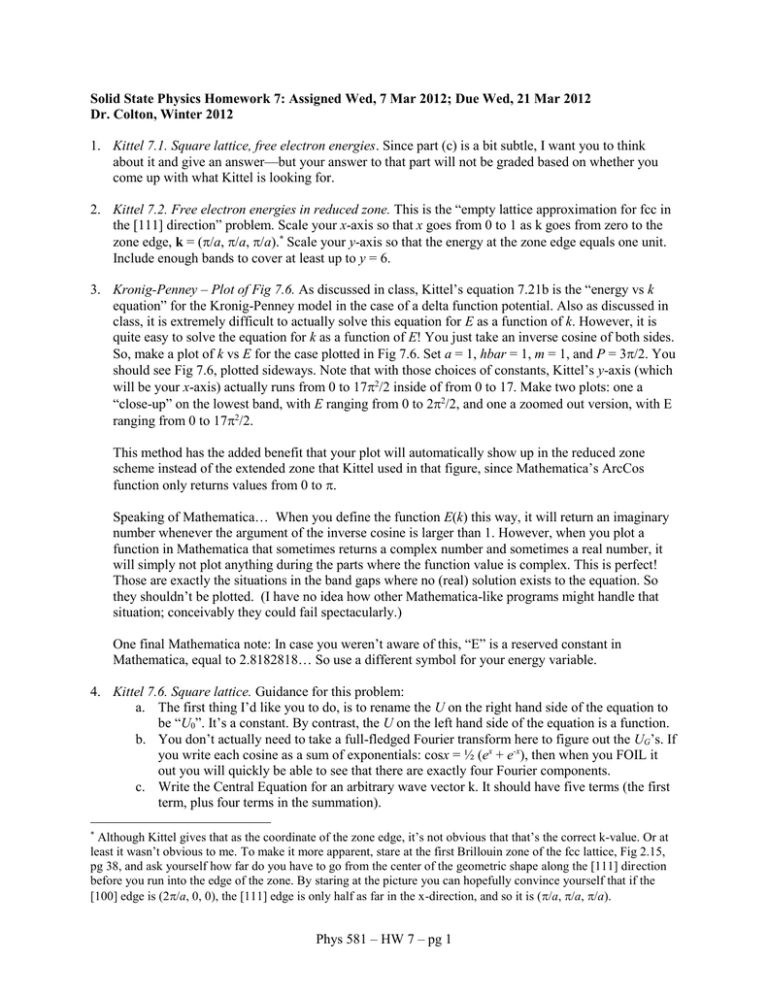
Solid State Physics Homework 7: Assigned Wed, 7 Mar 2012; Due Wed, 21 Mar 2012 Dr. Colton, Winter 2012 1. Kittel 7.1. Square lattice, free electron energies. Since part (c) is a bit subtle, I want you to think about it and give an answer—but your answer to that part will not be graded based on whether you come up with what Kittel is looking for. 2. Kittel 7.2. Free electron energies in reduced zone. This is the “empty lattice approximation for fcc in the [111] direction” problem. Scale your x-axis so that x goes from 0 to 1 as k goes from zero to the zone edge, k = (/a, /a, /a).* Scale your y-axis so that the energy at the zone edge equals one unit. Include enough bands to cover at least up to y = 6. 3. Kronig-Penney – Plot of Fig 7.6. As discussed in class, Kittel’s equation 7.21b is the “energy vs k equation” for the Kronig-Penney model in the case of a delta function potential. Also as discussed in class, it is extremely difficult to actually solve this equation for E as a function of k. However, it is quite easy to solve the equation for k as a function of E! You just take an inverse cosine of both sides. So, make a plot of k vs E for the case plotted in Fig 7.6. Set a = 1, hbar = 1, m = 1, and P = 3/2. You should see Fig 7.6, plotted sideways. Note that with those choices of constants, Kittel’s y-axis (which will be your x-axis) actually runs from 0 to 172/2 inside of from 0 to 17. Make two plots: one a “close-up” on the lowest band, with E ranging from 0 to 22/2, and one a zoomed out version, with E ranging from 0 to 172/2. This method has the added benefit that your plot will automatically show up in the reduced zone scheme instead of the extended zone that Kittel used in that figure, since Mathematica’s ArcCos function only returns values from 0 to . Speaking of Mathematica… When you define the function E(k) this way, it will return an imaginary number whenever the argument of the inverse cosine is larger than 1. However, when you plot a function in Mathematica that sometimes returns a complex number and sometimes a real number, it will simply not plot anything during the parts where the function value is complex. This is perfect! Those are exactly the situations in the band gaps where no (real) solution exists to the equation. So they shouldn’t be plotted. (I have no idea how other Mathematica-like programs might handle that situation; conceivably they could fail spectacularly.) One final Mathematica note: In case you weren’t aware of this, “E” is a reserved constant in Mathematica, equal to 2.8182818… So use a different symbol for your energy variable. 4. Kittel 7.6. Square lattice. Guidance for this problem: a. The first thing I’d like you to do, is to rename the U on the right hand side of the equation to be “U0”. It’s a constant. By contrast, the U on the left hand side of the equation is a function. b. You don’t actually need to take a full-fledged Fourier transform here to figure out the UG’s. If you write each cosine as a sum of exponentials: cosx = ½ (ex + e-x), then when you FOIL it out you will quickly be able to see that there are exactly four Fourier components. c. Write the Central Equation for an arbitrary wave vector k. It should have five terms (the first term, plus four terms in the summation). Although Kittel gives that as the coordinate of the zone edge, it’s not obvious that that’s the correct k-value. Or at least it wasn’t obvious to me. To make it more apparent, stare at the first Brillouin zone of the fcc lattice, Fig 2.15, pg 38, and ask yourself how far do you have to go from the center of the geometric shape along the [111] direction before you run into the edge of the zone. By staring at the picture you can hopefully convince yourself that if the [100] edge is (2/a, 0, 0), the [111] edge is only half as far in the x-direction, and so it is (/a, /a, /a). * Phys 581 – HW 7 – pg 1 d. Now consider a specific k value: k = (/a, /a). As discussed in class, the Central Equation for a particular k is coupled via the C coefficients to similar equations for all of the other k’s that are connected to that k by a reciprocal lattice vector. That’s an infinite number of equations because there are an infinite number of RLVs. So, to actually solve a real problem, you need to make a choice of how many additional equations to use. For this problem, since Kittel says you’re looking for a 22 matrix equation, you should use only one additional equation. That additional equation will be the one for k = (–/a, –/a) (in some sense, the “closest” k to the one you’re looking for). In your two equations, set all of the C coefficients for k’s that are not one of those two k-values equal to zero. You will then have two unknown C values, and two coupled equations which you can solve via matrix techniques to obtain two values for the energy. 5. Perturbation theory and sodium. (Based on Stokes problem 8-16.) Consider sodium atoms in a bcc lattice. Let’s model the crystal potential U(x,y,z) as constant potential U0 in a small cubic area (side 2b) centered on each atom, and as zero everywhere else. Let’s arbitrarily force b to be equal to a/4 (a is the lattice constant, which you can find in a table in chapter 1). (a) Use an experimental measurement along with degenerate perturbation theory to deduce what U0 would have to be in this model. The experimental measurement is that the energy gap at the boundary of the first Brillouin zone along the [110] direction is found to be 0.5 eV. Hint: We know that at the BZ boundary, the “degenerate perturbation theory” result relates the gap energy to the Ukk integral. Here k = /a (1,1,0), the edge of the Brillouin zone in the [110] direction… but what is k? That’s the first thing you have to figure out: what is a wavevector k that is connected to k via a primitive RLV and which corresponds to the same energy as k. Hint 2: Once you have figured out the appropriate k, you need to calculate the integral, Ukk. You’ll get an answer in terms of U0. From the perturbation theory handout, you should know that Ukk = ½ Egap, so you can use the experimental gap energy to determine U0. (b) Use your value for U0 to calculate the energy of an electron state at the Fermi surface in the [110] direction. Give this as a sum of three terms: the zeroeth, first, and second order terms from Eqn 4 in the perturbation theory handout. Hint: You’ll need to find the Fermi wave vector. You can get the magnitude from Table 6.1. The direction is given by the unit vector 1/sqrt(2) (1,1,0). Hint 2: The zeroeth order energy is easy, the first order energy correction is not too bad (you’ll have to do a simple integral), but the second order energy correction is tricky. In the second order calculation, there is a summation over all k values. As in the previous problem, that’s an infinite summation which we’ll need to truncate. Choose to keep just the first 12 terms which are the 12 nearest neighbors in reciprocal space. You’ll have to work out what those k-vectors are by thinking about the reciprocal lattice vectors of the bcc lattice. You can approximate the numerators as the square of the same Ukk value you used in part (a), constant for all terms in the summation. The denominators will be different for each k value. When I added up all the terms, I got a total second order correction of –0.076 eV. Final important note: You have to do integrals to get Ukk and Ukk. In my handout I set up the integrals as: (1/volume of whole crystal), times an integral over the whole crystal volume. However, Phys 581 – HW 7 – pg 2 they are also equal to: (1/volume of unit cell), times an integral over the volume of a single unit cell. That’s an easier form to deal with. But be careful—the volume of a unit cell for bcc is not just a3. 6. Perturbation theory handout: filling in some gaps. In the perturbation theory handout I arrive at this equation on page 6 after “skipping several lines of algebra”. Ek Ek0,ave U kk 1 4 E 0 k , diff 2 U kk 2 Go through the algebra from the matrix equation to solve for Ek, and show that this is indeed the equation that results. Phys 581 – HW 7 – pg 3
